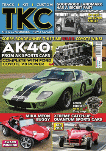George Holmes was a trained agricultural engineer who had been running a grocer’s shop in the Croydon area before moving to Camber Sands, East Sussex. His friend, Derek Bishop, from Greenwich, had previously run Heron Plastics and had been responsible for the Heron Europa and also for producing the bodies for Don Sim’s Diva operation. Meanwhile, down in East Sussex, George had bought a Nissen hut that was being used as a garage with two petrol pumps outside. A desolate location.
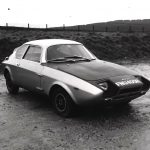
The Camber was underpinned by a square tube steel chassis with Mini subframes and mechanicals while the body was a hefty GRP affair reinforced with steel with a bulbous front end dictated by a front engine installation. The A-Series was front-mounted.
The car was launched at the Racing Car Show in 1967. Manufactured by West Engineers, located in a little garage located right on the sands. It was marketed by car accessory specialists, Checkpoint Race & Rally Equipment Ltd with a chap called Stewart Walters in charge of the Camber GT arrangement.
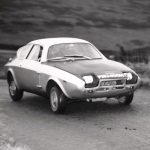
Things were running so behind with the show looming that Hastings engineering company, Mogram Engineering was enlisted to help and get the cars ready for the launch. Indeed, Mogram produced all but the first three Camber/Maya bodies (they’d been made by Heron).
Checkpoint would also later buy out Mogram, incidentally.
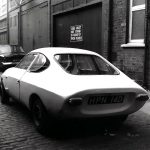
A former Checkpoint employee told me once that the project cost them over £10,000 (about £127,000 allowing for adjustment in today’s money!). The same person also told me that Mini designer Sir Alec Issigonis saw the car at the Racing Car Show and reckoned it was the only Mini-based special that he was happy with. It’s said that when he saw a Mini-based ‘special’ he’d usually be heard to say: “Oh god, what have they done to my baby, now!’
Checkpoint was one of the many ‘speed’ companies that sprung up in the sixties and were a pretty big player with branches in Glossop, London and Manchester, which was their HQ. They specialised in camshafts, cylinder heads and race engines plus the ubiquitous rally jacket. They would also go on to buy out the very well-known Mini and Imp specialist tuners Nerus Engineering in Rye run by Harry Weslake’s one-time right-hand-man and development engineer, Frank Webb.
The Camber GT kits were sold in stages with Kit No.1 at £435 being the body/chassis unit which bought the customer the, er, body and chassis units, rectangular side impact cross-members and a cruciform reinforced section.
I remember speaking to another chap who once worked for George Holmes at West Engineers and he said he travelled the 54 miles and back across country (horrible journey) from Horley, Surrey every day as skilled labour was hard to find in the Camber Sands area at the time.
The Mini’s front and rear subframes were installed to the Camber’s chassis, while the body kit included a pre-fitted laminated windscreen, toughened glass side and rear windows and for some reason, Perspex for the rear quarter lights. The doors were also pre-hung for the customer with locks and door furniture also fitted.
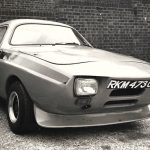
Kit No 2 consisted of what Holmes and Bishop described as essential extras such as a fuel tank from a Mini Van, radiator hoses, bespoke speedo cable, Cibie rectangular headlights, seats, battery and a Kenlowe fan. They even threw in a jack. This package cost £88.
Kit No.3, at £53, added interior trim and seats, with Kit No 4 featuring the brakes, and suspension parts including Koni dampers, anti-roll bar, servo, steel wheels and Dunlop tyres. A bargain at £94, surely.
Other packs – up to number 7 – were also listed – Kit No 5A was for customers using the Mini Cooper ‘S’ as a donor, for example.
If you wished, you could buy a Camber GT in turnkey form from £843 for the standard Mini or Cooper or £23 extra for the Cooper ‘S’, version.
The headlights were found to be illegally low, although Checkpoint did modify the sixth (and final) car built with rectangular units.
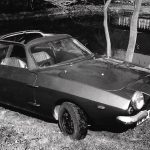
Holmes fell out with Checkpoint and Derek Bishop. The dispute was due to Checkpoint wanting more input as they funded the project but George resisted oh and accusations from Checkpoint that George had been selling cars out of the back door!
Derek subsequently went his own way and revised the car back at his East Sussex base where it became known as the Maya GT. It has been said that Checkpoint was losing interest in the car after the disagreement with Holmes.
He restyled the front end and sorted out the illegal headlight issue and named the revised car, after his wife’s horse, Maya! It was initially going to be called Maya Maynot!
The GRP featured a steel roll-hoop built into the roofline. The body was bonded to the chassis. Body/Chassis kits were priced at £390 or alternatively, W.West (Engineers) Ltd would convert a customer’s Mini donor from £495.
Without Checkpoint – or Bishop putting cash in – Holmes would have struggled but even then, the company was always short of cash and made extra income by producing GRP plant pots and planters and via forecourt petrol sales as the company also had the barren filling station in Camber Sands.
Tragically, Holmes was killed when out driving the Maya demonstrator after he had stopped to tend to an injured bird and was run over. Due to a lawsuit from Checkpoint, he had been made bankrupt just before his death, too.
The project stopped immediately although the body moulds were collected by Checkpoint who did briefly consider putting a revised version back into production via their Mogram Engineering operation.
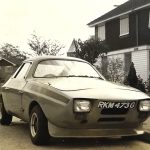
Checkpoint Race and Rally Equipment Ltd 1967
W.West (Engineers) Ltd 1967-69
Approx 7 made

